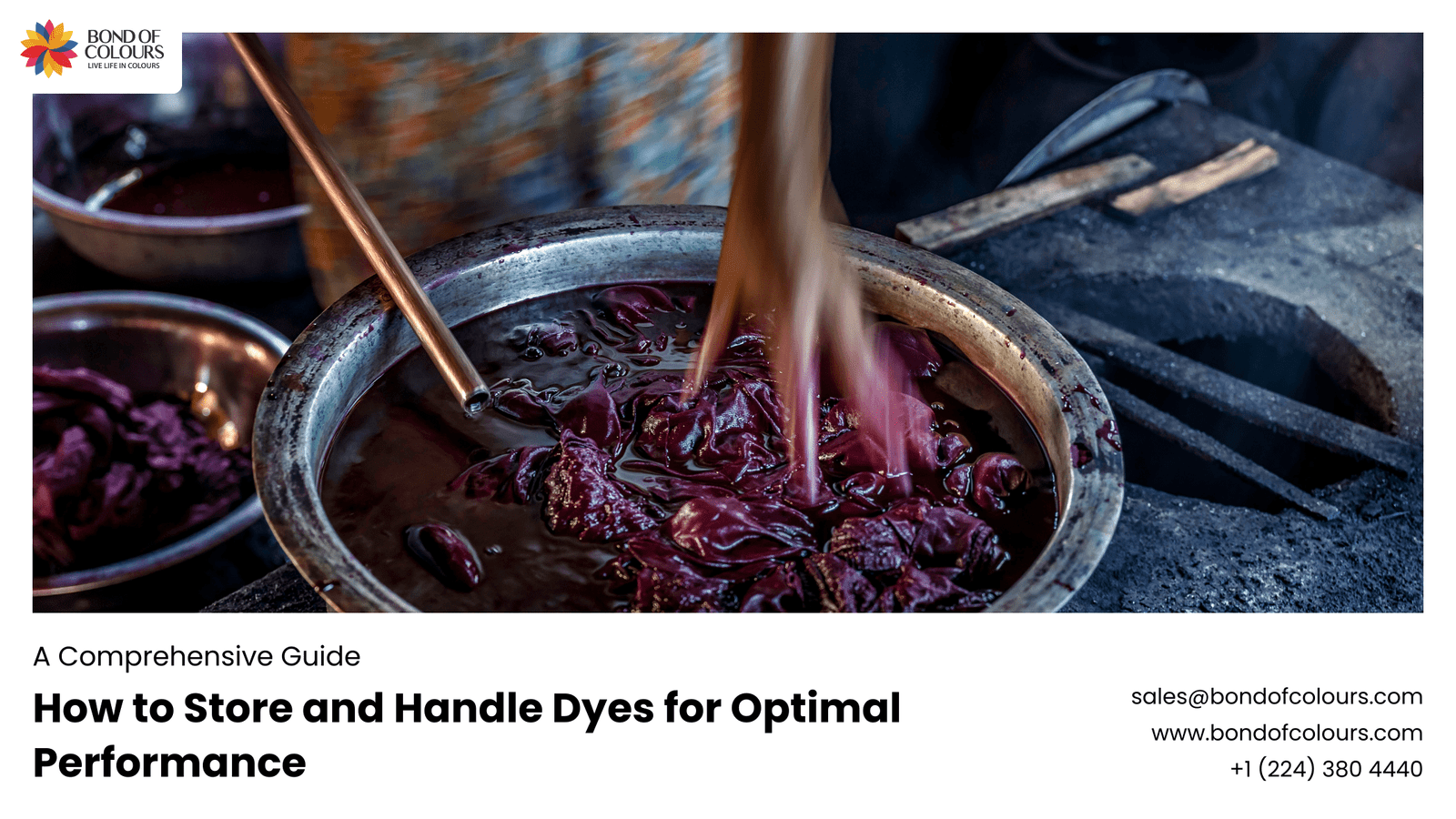Address
304 North Cardinal
St. Dorchester Center, MA 02124
Work Hours
Monday to Friday: 7AM - 7PM
Weekend: 10AM - 5PM
Address
304 North Cardinal
St. Dorchester Center, MA 02124
Work Hours
Monday to Friday: 7AM - 7PM
Weekend: 10AM - 5PM
Learn the best practices on how to store and handle dyes for optimal performance. Discover tips on maintaining dye quality, preventing contamination, and extending shelf life.

When it comes to achieving vibrant and consistent results in any dyeing project, how you store and handle your dyes is just as important as the application process itself. Whether you’re working with natural or synthetic dyes, proper storage and handling can significantly impact the performance and longevity of your dyes. Let’s dive into the best practices for storing and handling dyes to ensure you get the most out of them.
Dyes are colored substances that chemically bond to materials they are applied to, imparting color. Unlike pigments, which sit on the surface, dyes penetrate the fibers, offering more vibrant and long-lasting color.
Natural dyes are derived from plants, minerals, and animals. Examples include indigo, turmeric, and cochineal. They are eco-friendly and often preferred for their unique hues and environmental benefits.
Synthetic dyes are man-made, typically from petrochemicals. They include acid dyes, reactive dyes, and direct dyes. These dyes are known for their wide range of colors and superior colorfastness.
Improper storage can lead to the degradation of dyes, resulting in diminished color intensity and consistency. This can affect the final outcome of your dyeing projects.
Poor storage conditions can cause dyes to clump, dry out, or even become contaminated, rendering them unusable and leading to potential waste and additional costs.
Maintaining a stable, cool temperature is vital for preserving the quality of your dyes. Extreme temperatures can alter the chemical composition of dyes.
Keeping humidity levels low prevents dyes from absorbing moisture, which can cause clumping or degradation.
Light, especially UV rays, can break down dyes over time. Storing dyes in dark or opaque containers helps maintain their integrity.
Natural dyes should be stored in airtight containers to prevent exposure to air and moisture. Keeping them in a cool, dark place will help maintain their potency.
Synthetic dyes often come with specific storage instructions. Generally, they should be kept in tightly sealed containers away from direct sunlight and heat sources.
Always use appropriate PPE such as gloves, masks, and protective eyewear when handling dyes to avoid skin irritation or inhalation of fine particles.
Handle dyes in well-ventilated areas and avoid direct contact with skin and eyes. Use dedicated tools and containers to prevent cross-contamination.
Most dyes perform best when stored at temperatures between 50°F to 70°F (10°C to 21°C). Avoid storing dyes in areas prone to temperature fluctuations.
Frequent changes in temperature can cause dyes to expand and contract, leading to potential leaks or spills and degradation of the dye quality.
Aim to keep humidity levels below 50% to prevent dyes from absorbing moisture. Using dehumidifiers can help maintain the ideal environment.
Store dyes in moisture-proof containers and consider using silica gel packets to absorb excess moisture.
Prolonged exposure to light can cause dyes to fade or break down chemically. This is particularly true for natural dyes.
Opaque or UV-resistant containers are ideal for protecting dyes from light exposure. Storing dyes in dark cabinets or storage rooms can also be effective.
Use airtight, non-reactive containers like glass jars or high-density polyethylene (HDPE) bottles. Ensure that lids are secure to prevent air and moisture ingress.
Always label your containers with the type of dye and the date of storage. This practice helps keep track of shelf life and usability.
Dust, dirt, and other foreign particles can contaminate dyes, affecting their purity and performance.
Store dyes in clean, sealed containers and handle them with clean, dry tools. Avoid using the same scoop for different dyes to prevent cross-contamination.
Many dyes have a recommended shelf life. Using dyes past their expiry date can result in suboptimal results.
Proper storage conditions can extend the shelf life of dyes. Keeping them cool, dry, and protected from light is key.
Regularly inspecting your dye storage can help catch issues like leaks, contamination, or degradation early.
Check for signs of moisture, clumping, discoloration, or any changes in the dye’s consistency.
Follow local regulations for disposing of chemical substances. Many areas have specific guidelines for disposing of dyes.
Consider eco-friendly disposal methods and avoid pouring dyes down the drain as they can harm the environment.
Proper storage and handling of dyes are essential for maintaining their quality and performance. By following the guidelines outlined in this article, you can ensure that your dyes remain vibrant and effective for all your dyeing projects.
How long can dyes be stored? Dyes can typically be stored for several years if kept under proper conditions, but always check for any signs of degradation before use.
What are the signs that a dye has gone bad? Signs include changes in color, clumping, unpleasant odors, or reduced effectiveness in dyeing.
Can expired dyes still be used? Expired dyes can sometimes be used but may not produce the same intensity or consistency of color.
How should I dispose of old dyes? Dispose of old dyes according to local regulations. Many communities offer hazardous waste disposal programs.
What is the best way to store dyes for home use? For home use, store dyes in airtight containers in a cool, dark place, away from children and pets.